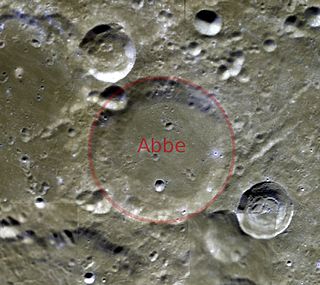 W
WAbbe is a lunar impact crater that is located in the southern hemisphere on the far side of the Moon. It is located just to the south of the crater Hess, and lies to the east of the large walled basin Poincaré. It is named after the German physicist Ernst Abbe.
 W
WBolyai is an old lunar impact crater that is located in the southern hemisphere on the far side of the Moon. To the southeast of Bolyai is the crater Eötvös, and to the north is Neujmin. It is named after the 19th century Hungarian mathematician János Bolyai.
 W
WBoyle is a lunar impact crater that is located in the southern hemisphere on the rugged far side of the Moon. It is adjacent to the larger crater Hess to the southeast, and lies about midway between the craters Alder to the north-northeast and Abbe to the south-southwest.
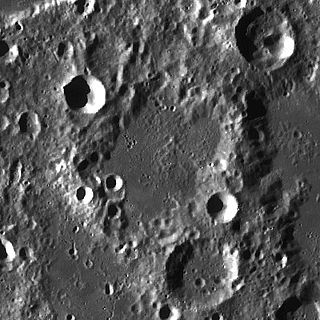 W
WCajori is a lunar impact crater that is located in the southern hemisphere on the far side of the Moon. It lies to the southwest of the walled plain Von Kármán, and to the east-southeast of the crater Chrétien.
 W
WCarver is a lunar impact crater that is located on the far side of the Moon, due east of the walled plain Van der Waals. To the northeast is the crater Rosseland, and to the south-southeast lies Kozyrev.
 W
WChrétien is a lunar impact crater that is located in the southern hemisphere on the far side of the Moon from the Earth. It lies due south of the Mare Ingenii, one of the few maria on the Moon's far side. The crater lies in the midpoint between the craters Garavito to the west-southwest and Oresme to the east-northeast, both of these being somewhat smaller than Chrétien.
 W
WCoblentz is a small lunar impact crater that is located on the far side of the Moon, to the south of the much larger crater Bolyai. This crater retains a circular rim, but it has been worn by impact erosion. This is particularly so at the southern end where an irregular gap exists in the rim. The interior floor is relatively featureless save for several tiny craterlets.
 W
WCori is a lunar impact crater that is located in the southern hemisphere on the far side of the Moon. It lies less than one crater diameter to the north of the crater Baldet. To the northeast is the crater Grissom. It is named after Gerty Cori, the first American woman to win the Nobel Prize and the first woman to win the prize in the category Nobel Prize in Physiology or Medicine.
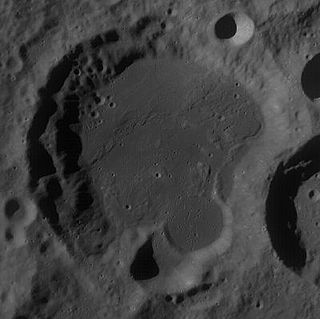 W
WCrocco is a lunar impact crater that is located on the far side of the Moon from the Earth. It is located to the northeast of the huge walled plain Planck, and northwest of the equally huge Poincaré. Just to the north, within one crater diameter, is the crater Koch.
 W
WEötvös is the remains of a lunar impact crater on the far side of the Moon. It lies to the north-northwest of the walled plain Roche, and east-southeast of the equally ruined Bolyai.
 W
WFechner is a lunar impact crater that lies on the far side of the Moon's southern hemisphere, attached to the western rim of the large walled plain Planck. The eastern rim of Fechner intersects the Vallis Planck, a long, wide cleft in the surface that follows a course to the north-northwest. This valley intrudes into the southeastern rim of the crater, then continues northwards from the periphery of the northeast rim.
 W
WGaravito is a lunar impact crater that is located in the southern hemisphere on the Moon's far side. It lies to the north-northwest of the huge walled plain Poincaré, and to the west of the crater Chrétien. It takes its name in honor of the Colombian astronomer and engineer Julio Garavito Armero.
 W
WHagen is a lunar impact crater on the far side of the Moon. It lies to the north of the huge walled plain Planck, and south-southwest of the crater Pauli.
 W
WHegu is a lunar impact crater that is located within Von Kármán crater on the far side of the Moon. The crater is located south of the landing site of the Chinese Chang'e 4 lander.
 W
WHess is a lunar impact crater that lies in the southern hemisphere on the far side of the Moon. The crater rim has been worn by subsequent impacts, leaving a low, eroded outer wall. The flat interior has been resurfaced by lava flows and is free of significant impacts. This floor has a slightly darker albedo than the surrounding terrain.
 W
WHildegard is an ancient impact crater in the southern far side of the Moon, northwest of the larger Planck.
 W
WHopmann is a lunar impact crater that lies in the southern hemisphere on the Moon's far side. It is attached to the northern part of the large walled plain Poincaré. Less than one crater diameter to the north-northwest is the crater Garavito.
 W
WJules Verne is a large lunar impact crater on the far side of the Moon, named after the French author. It is located to the west-southwest of the Mare Ingenii, one of the few lunar mares on the far side. To the southeast of Jules Verne is the crater Lundmark, while Koch is located to the south-southeast. To the northwest is the large walled plain Pavlov.
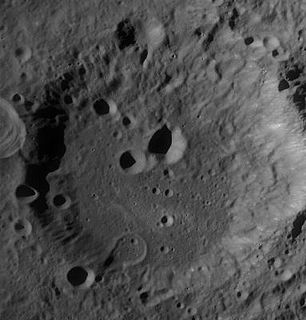 W
WKoch is a crater on the far side of the Moon. It lies in the southern hemisphere, to the south-southeast of the walled plain Jules Verne. Attached to the northeastern rim of Koch by a neck of uneven terrain is the crater Lundmark. Less than one crater diameter to the south of Koch is Crocco.
 W
WKozyrev is an impact crater on the far side of the Moon. It lies to the south-southeast of the crater Carver, and to the southwest of the Roche–Pauli crater pair.
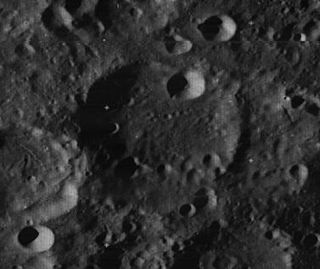 W
WLampland is a crater on the far side of the Moon. It lies to the west-southwest of the crater Subbotin, and to the north-northwest of Eötvös. About four crater diameters to the north-northwest lies the prominent Tsiolkovskiy.This is a torn Crater with a smaller pit intruding slightly into the west-southwestern rim. A smaller, cup-shaped impact crater Lampland A lies along the northeast inner wall and part of the floor. The interior of Lampland is marked by several small craterlets which are located mostly in the southern half. There is a slightly darker patch of terrain in the southeast part of the interior.
 W
WLeibnitz is a huge lunar impact crater that is located in the southern hemisphere on the far side of the Moon. This formation is the same size as Clavius on the near side. It is located to the east-southeast of Mare Ingenii, and is joined to the northeast rim of Von Kármán. Attached to the eastern rim of Leibnitz is Davisson, and intruding into the southeast rim is Finsen. Farther to the west is the large Oppenheimer.
 W
WLundmark is an eroded crater on the far side of the Moon. It lies to the southwest of the Mare Ingenii, one of the rare mare areas on the far side. Nearly attached to the southwestern outer rim of Lundmark is the crater Koch, and located to the northwest is the flooded Jules Verne.
 W
WLyman is a lunar impact crater that lies in the southern hemisphere on the far side of the Moon. It is located to the south of the huge walled plain Poincaré, and to the northeast of Schrödinger, another walled plain. To the east-southeast is the larger crater Minnaert.
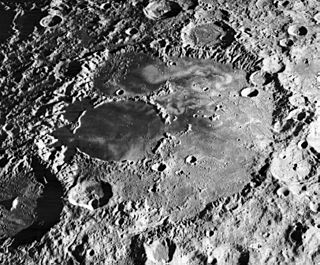 W
WMare Ingenii is one of the few lunar mare features on the far side of the Moon. The mare sits in the Ingenii basin, which is of the Pre-Nectarian epoch, which lies in turn in the outer part of the older and much larger South Pole–Aitken basin. The mare material located in Ingenii and the surrounding craters is of the Upper Imbrian epoch. The dark circular feature which dominates this mare is the crater Thomson, with the overflow from Ingenii/Thomson directly to the east. Mare Ingenii is incompletely and thinly covered over much of its expanse with mare lava sheets. The light grey crater to the south of Mare Ingenii is Obruchev.
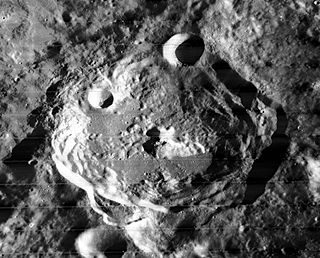 W
WO'Day is a prominent lunar impact crater that is located on the far side of the Moon. It intrudes into the northwestern edge of Mare Ingenii, and the rim is lower on that side. To the northwest is the crater pair of Holetschek and Sierpinski. Southwest of O'Day lies the crater Seidel. It is named in honour of the American physicist Marcus O'Day.
 W
WObruchev is a disintegrating lunar impact crater that lies along the southern shore of Mare Ingenii, on the far side of the Moon. Less than three crater diameters to the south of Obruchev is the crater Chrétien, and about the same distance to the southeast lies Oresme.
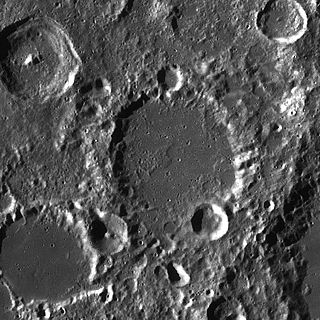 W
WOresme is a crater on the Moon's far side. It lies just to the west-northwest of the larger Von Kármán. To the southwest of Oresme is Chrétien, and to the northwest is the Mare Ingenii. This crater was believed to have formed during the Nectarian epoch, about 4 billion years ago.
 W
WPauli is a lunar impact crater that is located on the Moon's far side. It lies about halfway between the lunar equator and southern pole, across the southern rim of the larger walled plain Roche.
 W
WPikel'ner is an impact crater on the Moon's far side, named for the Russian astronomer Solomon Pikelner. It lies to the southeast of the larger crater Van der Waals, and to the north of the Vallis Planck cleft. Pikel'ner overlies more than half of the satellite crater Pikel'ner Y to the north. Almost contacting the southwestern outer rim of Pikel'ner is a larger concentric crater formation with the smaller crater of the pair, Pikel'ner S, along the northern edge of the pair.
 W
WPlanck is a large lunar impact crater, approximately 319 kilometers in diameter, that is located in the southern hemisphere of the Moon, on the far side as seen from the Earth. It lies to the west of the walled plain Poincaré, another enormous formation only slightly larger than Planck. Both formations are larger than the walled plain Bailly, the largest crater on the near side. Lying across the southeast rim of Planck is the crater Prandtl, to the northeast is Hildegard, and to the west is Fechner.
 W
WPoincaré is a large lunar impact basin that lies in the southern hemisphere on the far side of the Moon. Most of the formation has been heavily eroded by subsequent impacts, leaving a battered formation with only rugged remnants of the original outer rim to the west.
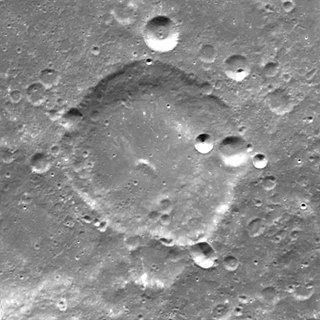 W
WPrandtl is an impact crater on the far side of the Moon. It lies across the southeastern outer rim of the huge walled plain Planck.
 W
WRamsay is a lunar impact crater that is located on the Moon's far side. It lies to the south-southwest of the larger crater Jules Verne, and is nearly in contact with the satellite crater Jules Verne P along the northern outer rim. To the southeast of Ramsay is the crater Koch, and to the west-southwest lies the overlapping pair of Roche and Pauli.
 W
WRoche is a large crater on the far side of the Moon from the Earth. The prominent crater Pauli lies across the southern rim of Roche, and the outer rampart of Pauli covers a portion of Roche's interior floor. To the north-northwest of Roche is the crater Eötvös, and just to the west-northwest lies Rosseland.
 W
WRosseland is a lunar impact crater on the far side of the Moon. It lies less than one crater diameter to the northeast of Carver, and about the same distance to the west of the larger Roche. To the northwest lies the smaller Coblentz.
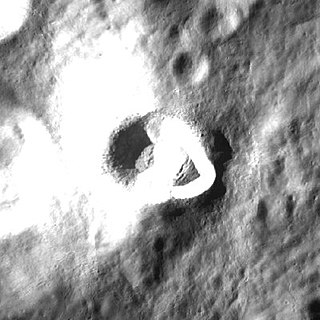 W
WRyder is a crater on the far side of the Moon. It is located in a patch of higher albedo surface material to the east of the larger Roche–Pauli crater pair. The name for this crater was officially approved at the IAU general assembly in 2006.
 W
WSeidel is a worn lunar impact crater that lies to the east-northeast of the much larger crater Jules Verne. Farther to the east of Seidel is the western edge of Mare Ingenii, and to the northeast lies the crater O'Day.
 W
WTen Bruggencate is a lunar impact crater that lies on the far side of the Moon from the Earth, just to the east of the younger crater Lane. To the southeast of Ten Bruggencate is Chauvenet.
 W
WThomson is a lunar impact crater that is located within the Mare Ingenii on the far side of the Moon. Just to the northeast is the unusual merged crater formation of Van de Graaff. On the northwest rim of the mare is O'Day, and to the south-southwest is Obruchev on the southern shore of Mare Ingenii.
 W
WTianjin is a lunar impact crater that is located within Von Kármán crater on the far side of the Moon. The crater is located northeast of the landing site of the Chinese Chang'e 4 lander.
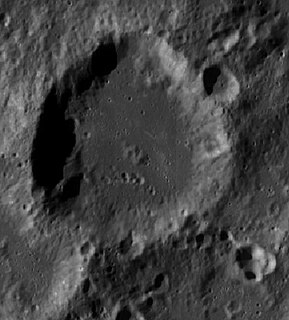 W
WTseraskiy (Ceraski) is an impact crater on the Moon's far side, approximately 66 kilometers (41 mi) in diameter. It is located to the north-northeast of the huge walled plain Planck, and to the southeast of the crater Pauli. To the east-northeast of Tseraskiy is Crocco.
 W
WVaughan is a lunar impact crater that is located on the southern hemisphere on the far side of the Moon. It lies west of the crater Maksutov and north of Nishina. The crater has a bright system of rays and is thus young.
 W
WVon Kármán is a large lunar impact crater that is located in the southern hemisphere on the far side of the Moon. The crater is about 180 km (110 mi) in diameter and lies within an immense impact crater known as the South Pole–Aitken basin of roughly 2,500 km (1,600 mi) in diameter and 13 km (8.1 mi) deep. Von Kármán is the site of the first soft-landing on the lunar far side by the Chinese Chang'e 4 spacecraft on 3 January 2019.
 W
WZhinyu is a lunar impact crater that is located within Von Kármán crater on the far side of the Moon. The crater is located west of the landing site of the Chinese Chang'e 4 lander.